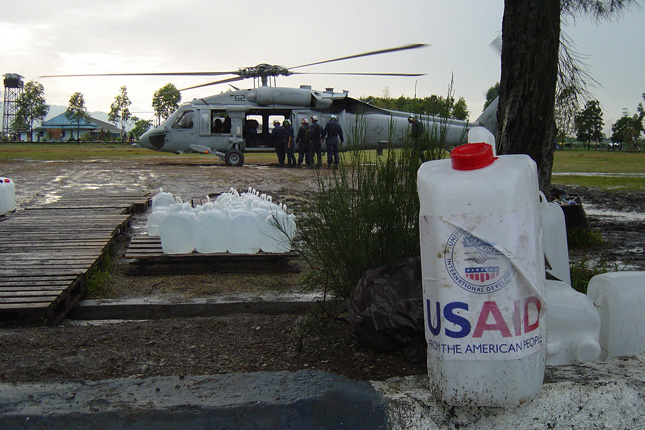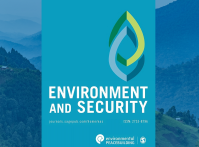-
The “Most Important Issue We Face”: New U.S. Global Strategy for Water Emphasizes Health and Security
November 29, 2017 By Wilson Center Staff
“Water may be the most important issue we face for the next generation,” writes President Donald J. Trump on the first page of the first-ever U.S. Global Water Strategy. Prepared by the U.S. State Department and released in mid-November, the landmark report was required by Congress’ bipartisan Senator Paul Simon Water for the World Act of 2014. During the public comments phase, the New Security Beat published recommendations from its fellows and experts. Now that it is out, we’ve asked them to share their thoughts on the final report.
Ruth Greenspan Bell, Wilson Center Public Policy Fellow:
We live in exceptional times when we are relieved to see in print a U.S. government report that offers very mainline, indisputable objectives and observations, such as:
- Making safe drinking water, sanitation, and improved hygiene (WASH) practices available even in poor, underserved populations;
- Referencing the connection between water-resources management, development goals, and state fragility; and,
- Acknowledging that shared waters can be a source of tension and conflict that must be addressed.
My top recommendation for next steps is to fund—adequately—the institutions of government whose responsibility it is to implement the strategy and to give them the support they need to succeed in this important venture. The proof is always in the pudding.
Ken Conca, Professor, American University, and Wilson Center Global Fellow:
The Global Water Strategy takes water seriously: it acknowledges the need for coherence and coordination across the U.S. government; and it recognizes the strong cooperative opportunities around water. Unfortunately, the strategy ignores two fundamental realities of today’s water world: (1) the need for climate-smart water policies; and, (2) the mobilizing power of rights-based approaches.
Water is the delivery mechanism for climate change, so overlooking its effects has real consequences: The strategy’s list of priority countries includes only a few identified as most vulnerable or least resilient to climate effects. The United States cannot focus its efforts “where needs and opportunities are greatest” without a clear, transparent commitment to climate-smart decisions.
The strategy is equally silent on human rights. Short-term access to water may be a technical task, but sustaining that access requires a rights-based enabling environment, including access to information, participation in decision-making, and rights of redress. It also means recognizing people’s right to water: of a certain quality, in an adequate quantity, and at a manageable proximity.
Without engaging these realities, U.S. international water policy seems destined to remain characterized by poor coordination, inconsistent priorities, and subordination to other agendas—in short, a lack of strategy.
Sherri Goodman, Wilson Center Senior Fellow:
The U.S. Global Water Strategy sets forth a bold vision for a “water-secure world,” recognizing that sustainable supplies of water are deeply connected to our national security. It clearly reflects the importance of hydrodiplomacy: One of its strategic objectives is to “reduce conflict by promoting cooperation on shared waters,” noting that “countries that cooperate on water are less likely to go to war.” Congress should take the next step in advancing the Global Water Strategy by supporting the creation of a Center for Water Conflict Prevention. Congress should also support the recommendation to invest in sustainable infrastructure and services, and promote science, technology, and innovation, all of which are key to advancing global water security.
John Oldfield, Principal, Global Water 2020:
The Global Water Strategy provides clear opportunities to (1) accelerate progress toward safe drinking water and sanitation across the developing world; and, (2) get ahead of preventable water-related security threats to the United States and our allies, including conflict, disease, and famine. The strategy rightly focuses less on direct services and more on ways public and private stakeholders in the United States can strengthen governance and financial capacity across the developing world.
However, two critical areas are poorly detailed in this strategy:
- How will the water and health teams across U.S. agencies work together on the clear linkages between water, sanitation, and infectious diseases?
- How can the members of the Interagency Water Working Group collaborate more broadly and effectively over the next five years, and will they have a clear mandate, people, and resources at their disposal?
Individual agencies must now detail their implementation plans for the next five years, and indicate the resources needed to carry them out. Non-government stakeholders must look for creative ways to partner with the U.S. government. And the U.S. Congress must continue to provide oversight and consistent, targeted funding.
Karin Krchnak & David Reed, World Wildlife Fund:
The Global Water Strategy is no small achievement. For the first time, we see a holistic understanding of the critical role water plays for development, defense, and diplomacy: Good water management is linked to greater stability, improved relations across borders, and secure ecosystem services. Climate change, population growth, changing consumption patterns, and poor water governance underscore the urgent the need for this whole-of-government approach.
However, we have concerns about the ability to achieve the strategy’s objectives. In particular, without new metrics that reflect the strategy’s integrated approach, implementation will continue to center on WASH efforts, which already have clear indicators. For example, the strategy’s country-specific plans show little of the integration present in the Strategic Objectives and Approaches section. This narrow focus on WASH without water resources management and governance misses opportunities to increase stability and the long-term sustainability of U.S. government investments; addressing these challenges sooner will help ensure success and bring us closer to a water-secure future. WWF stands ready to leverage our science, tools, and water resource management and conservation experience to help as the U.S. government operationalizes the strategy.
Sources: Notre Dame Global Adaptation Initiative, U.S. Congress
Photo Credits: Preparation of clean water delivery by helicopter, January 2005, courtesy of USAID Indonesia.
 A Publication of the Stimson Center.
A Publication of the Stimson Center.






